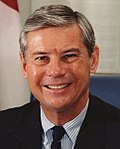| |||||||||||
| |||||||||||
| |||||||||||
This article lists those who were potential candidates for the Democratic nomination for Vice President of the United States in the 2000 election. Incumbent Vice President Al Gore won the 2000 Democratic nomination for President of the United States, and chose Connecticut Senator Joseph Lieberman as his running mate on August 7, 2000. [1] Lieberman, a centrist two-term Democratic senator, was chosen for being "tough on defense" and foreign policy issues. Lieberman was the first Jewish nominee chosen for a national ticket. [2] The choice of Lieberman was announced shortly before the 2000 Democratic National Convention. [2] Former Secretary of State Warren Christopher led the vetting process. [3] The Gore–Lieberman ticket ultimately lost to the Bush–Cheney ticket in the general election. Coincidental to the presidential election, Lieberman was re-elected to a third term as senator from Connecticut and subsequently changed his party affiliation to Independent in 2006.

























